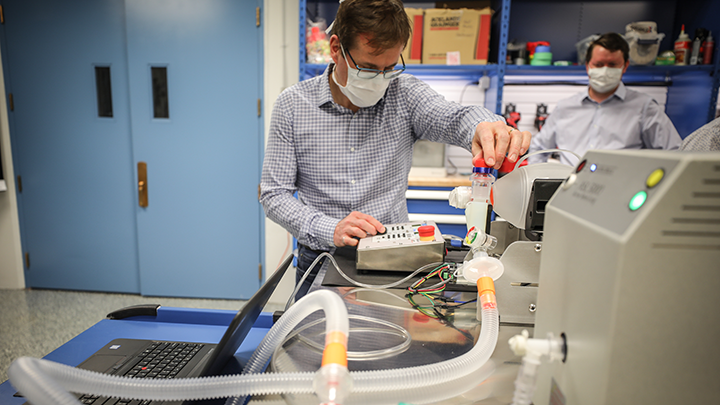
June 5, 2020

Exergy Solutions Project Manager Ian Buchanan runs a test on a ventilator.
Story by Greg Harris | Photo by Leah Hennel
When Billy Rideout saw how a shortage of ventilators caused a crisis in Italy in March, he thought about what his advanced technology firm, Exergy Solutions, might do to prevent a similar situation in Alberta.
Six weeks later, following a cross-industry collaboration led by project manager Ian Buchanan, Exergy was poised to donate 200 ventilators it designed and built as a response to the pandemic.
“We’re an agile organization, capable of moving fast,” Rideout says. “It’s something we’ve always been very proud of and during the last few months it has proven to be very helpful.”
Named Alberta E-Vent and nicknamed “Bertie”, the ventilators were created in part through 3D printing technology. They are intended to provide short-term respiratory support, monitoring and treatment of adult patients for use if and when a conventional ventilator is unavailable.
Suncor Energy, a long-term partner of Exergy, provided financial support to the Exergy team to make the donation of the first 200 units possible.
When Exergy first approached Alberta Health Services (AHS) with its idea, it led to the creation of a multidisciplinary group called the Ventilator Collaborative, co-led by Dr. Braden Manns, AHS Associate Chief Medical Officer, Strategic Clinical Networks, and Patty Wickson, Executive Director of the AHS Innovation, Evidence and Impact team.
The Ventilator Collaborative brought together clinicians and industry representatives and involved a cross-provincial team of volunteers and collaborators.
“Exergy has some incredibly smart engineers and people who are willing to work 12 hours a day, seven days a week, but they needed some help to understand, ‘Which type of ventilator prototype should we be working on? How do we know if it’s going to be acceptable to the intensive care unit physicians and respiratory therapists who are going to be using them?’ and many other questions,” Dr. Manns says.
The Ventilator Collaborative eventually included university faculty from biomedical engineering and other disciplines, other industry representatives, AHS intensive care physicians, a respiratory therapist, as well as other clinicians who had biomedical engineering experience.
“With industry stepping up to try to solve a problem in healthcare, our task at AHS was to provide whatever information and feedback we could to help ensure they succeeded,” Wickson says. Weekly meetings of the collaborative covered a range of technical topics related to the clinical use of the ventilators, and also dealt with testing, legal and regulatory matters.
Thanks to Albertans’ efforts to flatten the curve, the same sort of crisis that Italy faced never materialized here. Nevertheless, whatever the next phase of the pandemic may hold, the E-vent ventilators provide Albertans with a kind of life-saving insurance.
Should the need arise, Alberta E-Vent will allow hospitals to expand their patient-care capacity and reallocate conventional ventilators to patients with more complex needs.
Exergy’s lab is located in the Life Sciences Innovation Hub, operated by Innovate Calgary. Teams from the University of Calgary, including the Advanced Technical Skills Simulation Laboratory and Schulich School of Engineering, offered support and resources for the mechanical design and testing of the project.
Many other companies played pivotal roles in the collaboration, including Logican Technologies, Catch Engineering, PLC Electronic Solutions from Vancouver, Global Power Technologies and Laser Equation.